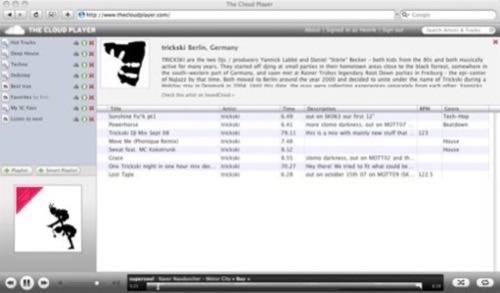These days, everybody’s talking about cloud computing – the notion that computing’s future lies in web-based applications and services and not in software tied to the desktop. After years of web app releases, we now have many solid alternatives to desktop tools ranging from office document creation tools to photoeditors. Yet still, some programs remained tied to the desktop with seemingly no plans to move elsewhere. iTunes is one of those programs.

We don’t really expect Apple to create a web-based iTunes anytime soon. Why should they? The company’s iPods and iPhones dominate the mp3 player market and are locked down so that they, in theory, could only work with the company’s iTunes software.
It’s only recently that we’ve seen any real attempts to free those devices for use with other programs. The open source desktop player Songbird looks to be the most promising of the bunch, but even it cannot support the newer iPod Touch devices and iPhones at this point. And like iTunes, Songbird is tied to the desktop. So an iTunes for the cloud? Forget about it.
Could SoundCloud Set Us Free?
But then we saw the player from SoundCloud, the company that “moves music.” Until now, SoundCloud has been focusing on their service that lets musicians and fans freely distribute and share tracks with each other via the web. Using widget-based dropboxes combined with a social network of fellow music fans, SoundCloud makes it simple to move large files over the web without having to resort to FTP, bitTorrent, or other complicated services.

Right now, their new Cloud Player doesn’t do all that much, we’ll admit. In fact, we’re sorry to say that it actually seems overwhelmed and broken. When trying to create a playlist, we just see the spinning circle. When we tried to play a track, all we got was a message: “transferring data from api.soundcloud.com.” Obviously, this app is nowhere near ready for primetime. It looks like a great idea, sure, but one that’s only a pretty picture of what could be. We love that idea, though – an app for finding and playing tracks, discovering music, saving playlists, even creating smart playlists – all in the cloud.

Yet with the Cloud Player’s iTunes-like interface, we could begin to imagine a new world where music could be shared, distributed, organized, and played, all over the web. The only missing piece to total music domination is device support. Assuming the Cloud Player ever worked, how could we get the music from the web to our iPods and iPhones?
The easy answer would be iPhone app, of course. But given that SoundCloud’s service is essentially a new platform for music distribution and discovery, it would actually be a competitor to iTunes, and Apple doesn’t tend to approve apps that offer competing services. To get approval, they would have to integrate with iTunes somehow, perhaps by presenting links to purchase songs in the iTunes online store. Alternately, they could forgo the iTunes App Store altogether and build something for the open-source Android OS instead…no worries about app approval there.
Yes, It’s Broken…But Is It Unique?
Let’s backtrack a little. We see that the Cloud Player is simply not a worthwhile app just yet. It doesn’t even work, so why are we bothering to review it? The answer is because SoundCloud, the company behind the app, is doing something different that many other online music streaming services do not: distribution and monitoring. Let me explain…
Here at ReadWriteWeb, we love services like Lala, The Hype Machine, and Last.fm for example. Hype Machine tracks mp3 blogs, Last.fm uses free music to encourage legal music sales, but Lala looks the most promising for a true move to the cloud. At least, so far. The company’s latest business model revolves around not just being your “jukebox in the sky” but letting you own tracks for streaming forever. 10 cents per track. $1 per album. With four major labels on board and lots of indies, the catalog looks good.

But how does Lala amass its music collection? From you, the user, uploading your mp3s to the web. Lala gives you the rights to the unlimited streaming of your own tracks, and everything else can be streamed just once. Combine that with an iPhone app and you’ve routed around iTunes altogether. (Guess that’s why it’s not approved yet).
Lala has it all except for one thing: the source of the tracks themselves – they had to come from somewhere, right? You probably either torrented them or purchased them…possibly even from iTunes. For Lala to beat iTunes at its own game, Lala needs direct access to the artists and their music.
That’s where SoundCloud is different. With their service that “moves music,” an artist could upload a track to SoundCloud, which then could immediately become available in your web-based iTunes replacement app (The Cloud Player), and perhaps then it could be instantly streamed over your mobile device, too. Meanwhile, when you’re on your desktop or netbook, you only need browse to the cloud player’s web site to have a fully functional music management tool where you make playlists, share them with friends, and seek out new music. Combine that with Lala’s and Last.fm’s model which lets you stream tracks for free to encourage purchases, and you have a system that no longer needs the desktop, the music labels, proprietary software or hardware. In addition, on the flip side, the artists using SoundCloud can track the distribution of their tracks, the number of plays, and more.
Sounds great, right? Well, if only it worked. The Cloud Player is open source, though. Maybe you can fix it?





















